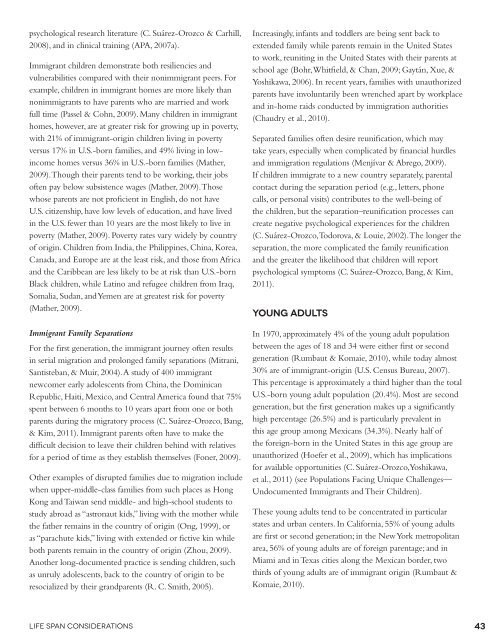Crossroads: The Psychology of Immigration in the New Century
Crossroads: The Psychology of Immigration in the New Century
Crossroads: The Psychology of Immigration in the New Century
Create successful ePaper yourself
Turn your PDF publications into a flip-book with our unique Google optimized e-Paper software.
psychological research literature (C. Suárez-Orozco & Carhill,<br />
2008), and <strong>in</strong> cl<strong>in</strong>ical tra<strong>in</strong><strong>in</strong>g (APA, 2007a).<br />
Immigrant children demonstrate both resiliencies and<br />
vulnerabilities compared with <strong>the</strong>ir nonimmigrant peers. For<br />
example, children <strong>in</strong> immigrant homes are more likely than<br />
nonimmigrants to have parents who are married and work<br />
full time (Passel & Cohn, 2009). Many children <strong>in</strong> immigrant<br />
homes, however, are at greater risk for grow<strong>in</strong>g up <strong>in</strong> poverty,<br />
with 21% <strong>of</strong> immigrant-orig<strong>in</strong> children liv<strong>in</strong>g <strong>in</strong> poverty<br />
versus 17% <strong>in</strong> U.S.-born families, and 49% liv<strong>in</strong>g <strong>in</strong> low<strong>in</strong>come<br />
homes versus 36% <strong>in</strong> U.S.-born families (Ma<strong>the</strong>r,<br />
2009). Though <strong>the</strong>ir parents tend to be work<strong>in</strong>g, <strong>the</strong>ir jobs<br />
<strong>of</strong>ten pay below subsistence wages (Ma<strong>the</strong>r, 2009). Those<br />
whose parents are not pr<strong>of</strong>icient <strong>in</strong> English, do not have<br />
U.S. citizenship, have low levels <strong>of</strong> education, and have lived<br />
<strong>in</strong> <strong>the</strong> U.S. fewer than 10 years are <strong>the</strong> most likely to live <strong>in</strong><br />
poverty (Ma<strong>the</strong>r, 2009). Poverty rates vary widely by country<br />
<strong>of</strong> orig<strong>in</strong>. Children from India, <strong>the</strong> Philipp<strong>in</strong>es, Ch<strong>in</strong>a, Korea,<br />
Canada, and Europe are at <strong>the</strong> least risk, and those from Africa<br />
and <strong>the</strong> Caribbean are less likely to be at risk than U.S.-born<br />
Black children, while Lat<strong>in</strong>o and refugee children from Iraq,<br />
Somalia, Sudan, and Yemen are at greatest risk for poverty<br />
(Ma<strong>the</strong>r, 2009).<br />
Immigrant Family Separations<br />
For <strong>the</strong> first generation, <strong>the</strong> immigrant journey <strong>of</strong>ten results<br />
<strong>in</strong> serial migration and prolonged family separations (Mitrani,<br />
Santisteban, & Muir, 2004). A study <strong>of</strong> 400 immigrant<br />
newcomer early adolescents from Ch<strong>in</strong>a, <strong>the</strong> Dom<strong>in</strong>ican<br />
Republic, Haiti, Mexico, and Central America found that 75%<br />
spent between 6 months to 10 years apart from one or both<br />
parents dur<strong>in</strong>g <strong>the</strong> migratory process (C. Suárez-Orozco, Bang,<br />
& Kim, 2011). Immigrant parents <strong>of</strong>ten have to make <strong>the</strong><br />
difficult decision to leave <strong>the</strong>ir children beh<strong>in</strong>d with relatives<br />
for a period <strong>of</strong> time as <strong>the</strong>y establish <strong>the</strong>mselves (Foner, 2009).<br />
O<strong>the</strong>r examples <strong>of</strong> disrupted families due to migration <strong>in</strong>clude<br />
when upper-middle-class families from such places as Hong<br />
Kong and Taiwan send middle- and high-school students to<br />
study abroad as “astronaut kids,” liv<strong>in</strong>g with <strong>the</strong> mo<strong>the</strong>r while<br />
<strong>the</strong> fa<strong>the</strong>r rema<strong>in</strong>s <strong>in</strong> <strong>the</strong> country <strong>of</strong> orig<strong>in</strong> (Ong, 1999), or<br />
as “parachute kids,” liv<strong>in</strong>g with extended or fictive k<strong>in</strong> while<br />
both parents rema<strong>in</strong> <strong>in</strong> <strong>the</strong> country <strong>of</strong> orig<strong>in</strong> (Zhou, 2009).<br />
Ano<strong>the</strong>r long-documented practice is send<strong>in</strong>g children, such<br />
as unruly adolescents, back to <strong>the</strong> country <strong>of</strong> orig<strong>in</strong> to be<br />
resocialized by <strong>the</strong>ir grandparents (R. C. Smith, 2005).<br />
Life Span Considerations<br />
Increas<strong>in</strong>gly, <strong>in</strong>fants and toddlers are be<strong>in</strong>g sent back to<br />
extended family while parents rema<strong>in</strong> <strong>in</strong> <strong>the</strong> United States<br />
to work, reunit<strong>in</strong>g <strong>in</strong> <strong>the</strong> United States with <strong>the</strong>ir parents at<br />
school age (Bohr, Whitfield, & Chan, 2009; Gaytán, Xue, &<br />
Yoshikawa, 2006). In recent years, families with unauthorized<br />
parents have <strong>in</strong>voluntarily been wrenched apart by workplace<br />
and <strong>in</strong>-home raids conducted by immigration authorities<br />
(Chaudry et al., 2010).<br />
Separated families <strong>of</strong>ten desire reunification, which may<br />
take years, especially when complicated by f<strong>in</strong>ancial hurdles<br />
and immigration regulations (Menjívar & Abrego, 2009).<br />
If children immigrate to a new country separately, parental<br />
contact dur<strong>in</strong>g <strong>the</strong> separation period (e.g., letters, phone<br />
calls, or personal visits) contributes to <strong>the</strong> well-be<strong>in</strong>g <strong>of</strong><br />
<strong>the</strong> children, but <strong>the</strong> separation–reunification processes can<br />
create negative psychological experiences for <strong>the</strong> children<br />
(C. Suárez-Orozco, Todorova, & Louie, 2002). <strong>The</strong> longer <strong>the</strong><br />
separation, <strong>the</strong> more complicated <strong>the</strong> family reunification<br />
and <strong>the</strong> greater <strong>the</strong> likelihood that children will report<br />
psychological symptoms (C. Suárez-Orozco, Bang, & Kim,<br />
2011).<br />
Young adults<br />
In 1970, approximately 4% <strong>of</strong> <strong>the</strong> young adult population<br />
between <strong>the</strong> ages <strong>of</strong> 18 and 34 were ei<strong>the</strong>r first or second<br />
generation (Rumbaut & Komaie, 2010), while today almost<br />
30% are <strong>of</strong> immigrant-orig<strong>in</strong> (U.S. Census Bureau, 2007).<br />
This percentage is approximately a third higher than <strong>the</strong> total<br />
U.S.-born young adult population (20.4%). Most are second<br />
generation, but <strong>the</strong> first generation makes up a significantly<br />
high percentage (26.5%) and is particularly prevalent <strong>in</strong><br />
this age group among Mexicans (34.3%). Nearly half <strong>of</strong><br />
<strong>the</strong> foreign-born <strong>in</strong> <strong>the</strong> United States <strong>in</strong> this age group are<br />
unauthorized (Hoefer et al., 2009), which has implications<br />
for available opportunities (C. Suárez-Orozco, Yoshikawa,<br />
et al., 2011) (see Populations Fac<strong>in</strong>g Unique Challenges—<br />
Undocumented Immigrants and <strong>The</strong>ir Children).<br />
<strong>The</strong>se young adults tend to be concentrated <strong>in</strong> particular<br />
states and urban centers. In California, 55% <strong>of</strong> young adults<br />
are first or second generation; <strong>in</strong> <strong>the</strong> <strong>New</strong> York metropolitan<br />
area, 56% <strong>of</strong> young adults are <strong>of</strong> foreign parentage; and <strong>in</strong><br />
Miami and <strong>in</strong> Texas cities along <strong>the</strong> Mexican border, two<br />
thirds <strong>of</strong> young adults are <strong>of</strong> immigrant orig<strong>in</strong> (Rumbaut &<br />
Komaie, 2010).<br />
43
















